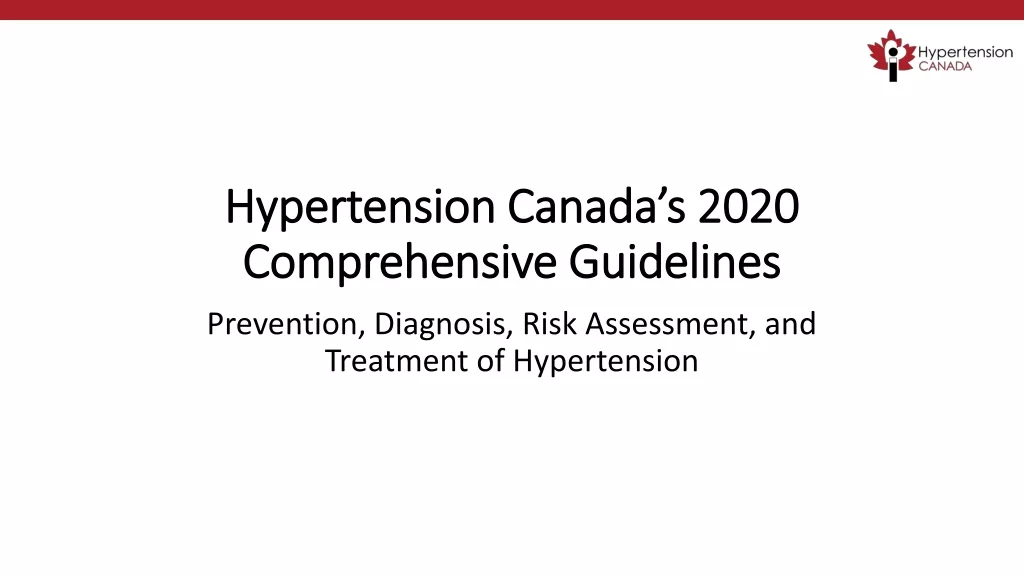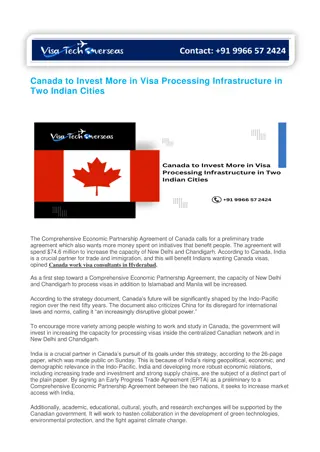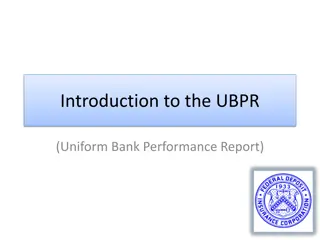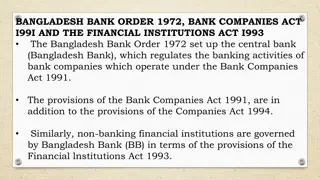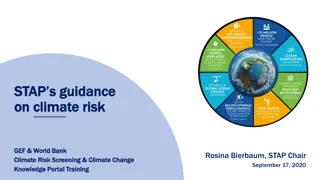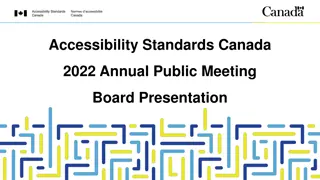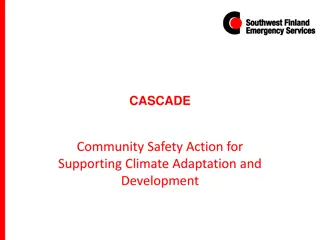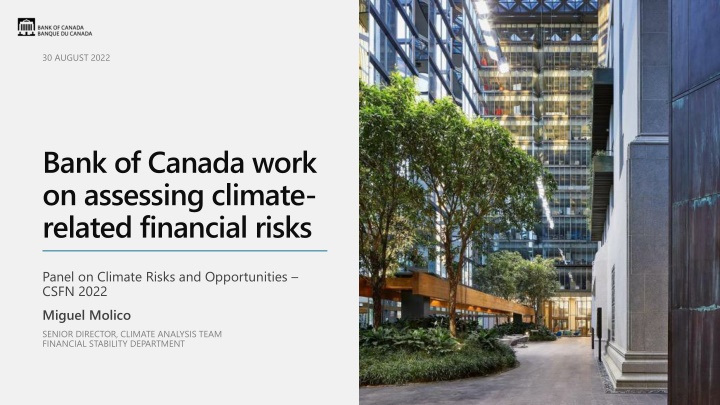
Bank of Canada Climate Risk Assessment
Bank of Canada is working on assessing climate-related financial risks through the Climate Scenario Analysis Pilot, aiming to enhance risk disclosure, understand sector exposure, governance, and risk management practices associated with transitioning to a low-carbon economy.
Download Presentation

Please find below an Image/Link to download the presentation.
The content on the website is provided AS IS for your information and personal use only. It may not be sold, licensed, or shared on other websites without obtaining consent from the author. If you encounter any issues during the download, it is possible that the publisher has removed the file from their server.
You are allowed to download the files provided on this website for personal or commercial use, subject to the condition that they are used lawfully. All files are the property of their respective owners.
The content on the website is provided AS IS for your information and personal use only. It may not be sold, licensed, or shared on other websites without obtaining consent from the author.
E N D
Presentation Transcript
30 AUGUST 2022 Bank of Canada work on assessing climate- related financial risks Panel on Climate Risks and Opportunities CSFN 2022 Miguel Molico SENIOR DIRECTOR, CLIMATE ANALYSIS TEAM FINANCIAL STABILITY DEPARTMENT
Protected B Overview PILOTPARTICIPANTS PILOT S OBJECTIVES Build the climate scenario analysis capability of authorities and financial institutions and support the Canadian financial sector in enhancing the disclosure of climate-related risks. Increase authorities and financial institutions understanding of the financial sector s potential exposure to risks associated with a transition to a low-carbon economy. Improve authorities understanding of financial institutions governance and risk management practices around climate-related risks and opportunities. Final report published 14 January 2022 3
Four climate transition scenarios Scenario Baseline (2019 policies) Climate policy ambition and timing The world follows a path consistent with climate policies in place at the end of 2019, implying a continued rise in emissions and an increase in average global temperature in the range of 2.9 3.1 C by 2100. Forestry continues on a global trend of being a net source of emissions through mid-century. Technological change The pace of technological change is slow. The availability of carbon dioxide removal (CDR) technologies is limited. Below 2oC immediate Starting in 2020, collective global action is taken to reduce emissions toward a target of below 2 C by 2100. Early investments, planning and management allow forests to become a small net sink by mid-century. After a decade of following 2019 policy frameworks, collective global action to align with a 2oC target begins in 2030. A steeper transition is needed to make up for the additional decade of a continued rise in emissions. Delayed investments, planning and management prohibit forests from becoming a net sink by mid-century. The pace of technological change is moderate. The availability of CDR technologies is limited. Below 2oC delayed The pace of technological change is moderate. The availability of CDR technologies is limited. Net-zero 2050 (1.5oC) Starting in 2020, collective global action is taken to reduce emissions toward a 1.5oC target. Current net-zero commitments by some countries, including Canada, are modelled directly in this scenario. Strong early investments enable forests to become a net sink by mid- century. The pace of technological change is fast. The availability of CDR technologies is moderate, including bioenergy with carbon capture and storage. Scenarios assume carbon pricing schemes are revenue-neutral - proceeds returned to households in the same period as lump sum transfers Scenarios are broadly aligned with NGFS scenarios narratives and global paths for emissions and carbon prices 4
Published scenario data Sectoral variables (not a comprehensive list) Scope 1 emissions Scope 2 emissions Input prices Output prices Direct emissions costs Indirect costs Capital expenditure Revenue Country/region Canada Canada Canada Canada Canada Canada Canada Canada Canada Canada United States United States United States United States World Macroeconomic variables Real GDP Inflation Y/Y Policy rate a.r. Real investment Nominal investment Nominal exchange rate (+ = depreciation) Real exchange rate (+ = depreciation) Employment Unemployment rate Energy prices US GDP US inflation Y/Y US policy rate a.r. Non-energy commodity prices Global GDP Country/region United States Canada Japan Europe China India Africa Rest of the world Refined oil products Energy-intensive industries Commercial transportation Electricity Sectors Crops Livestock Forestry Coal Oil & Gas Oil Gas Global Energy intensity Emissions intensity Production Climate transition scenario data - Bank of Canada
Change in net income across sectors Net zero 2050 (1.5oC) scenario versus baseline | Global 6
Transition is more costly for commodity exporters GDP level impact for Canada Net zero 2050 (1.5 C) Scenario GDP level impact for the world Net zero 2050 (1.5 C) Scenario Deviation from baseline, level percent Deviation from baseline, in percent 0 0 -3 -3 -6 -6 -9 -9 -12 -12 -15 -15 2020 2025 2030 2035 2040 2045 2050 2020 2025 2030 2035 2040 2045 2050 Global demand Commodity prices Domestic carbon tax Commodity Exporters World 7
8 Delayed global policy action increases economic impacts
Caveats The scenarios are not meant to be comprehensive or to predict the most likely outcome, rather explore plausible but intentionally adverse transition pathways that put pressure on industry to decarbonize Technological innovation could ease the transition on several sectors (e.g., blue hydrogen, biofuels, carbon capture, or co-producing non-combustion uses of bitumen) The scenarios do not consider innovation in new products or services or the creation of new industries or sectors (e.g., batteries and storage, hydrogen, mining technologies, alternative proteins, bioplastics) Other policies can also play an important role in easing the transition (e.g., alternative revenue recycling assumptions, supporting labour mobility) 9
Credit risk methodology Climate transition scenario variables mapped to financial impacts Calibration of credit model linking financial impacts to credit outcomes Portfolio impact assessment Borrower-level assessments (on sample of portfolio) Top-down component Bottom-up component 10
Estimated climate transition-credit risk relationship (Canada) Based on FIs pooled sample data 11
Equity valuation impacts vary across sectors Canadian Oil and Gas Sector Equity Valuation Canadian electricity Sector Equity Valuation 1.8 1.8 1.6 1.6 Scenario value relative to baseline Scenario value relative to baseline 1.4 1.4 baseline 2020 = 1 baseline 2020 = 1 1.2 1.2 1 1 0.8 0.8 0.6 0.6 Below 2 C delayed 0.4 0.4 Below 2 C immediate Net-zero 2050 (1.5 C) 0.2 0.2 0 0 2020 2025 2030 2035 2040 2045 2050 2020 2025 2030 2035 2040 2045 2050 12
Lessons learned and challenges FIs in early stages of building climate scenario analysis capability Pilot methodologies helped FIs identify data gaps and develop a deeper understanding and awareness of the impacts of the climate transition on their portfolios Analysis presented some data and methodological challenges and brought to light consistency and comparability issues across FIs assessments Lack of geographic and (granular) sectoral information on counterparties Challenging to map FIs exposures to scenario sectors/industries Many counterparties operate across multiple industries/business line Limited counterparty emissions data Lack of standardized approaches/methodologies to assess risks over longtime horizon Requires making many assumptions 13
Assessing Financial System Exposure to Climate Transition Risk Develop top-down climate transition systemic risk assessment capabilities Expand pilot analysis to capture exposures of the broader Canadian financial system (banks, credit unions, insurers, pension funds, investment funds) Analyze channels of systemic risk transmission The project leverages transition scenarios and methods from the recent BoC-OSFI Climate Scenario Analysis Pilot The Bank is collaborating with federal and provincial regulators as well as financial institutions to address data gaps enabling a pan-Canadian assessment of the financial system impacts
Assessing Financial System Exposure to Acute Physical Risks Current focus on flood risks to residential real estate sector and mortgage portfolios of financial institutions Objectives: 1. 2. 3. assess credit risk on bank s portfolios identify hot spots across Canada assess insurers exposure and insurance gaps Working with: Public Safety Canada: Granular flooding hazard (current and projected under climate scenarios) and damage data Federal and provincial regulators: mortgage data Insurance industry: Flood insurance data


